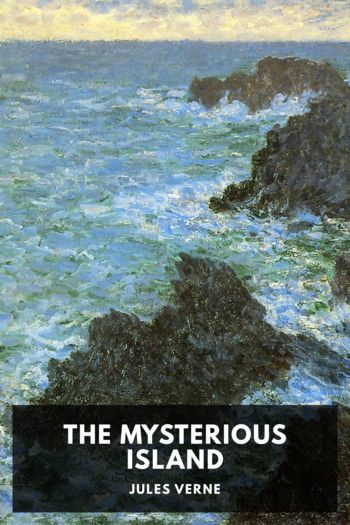An Antarctic Mystery, Jules Verne [ereader that reads to you TXT] 📗

- Author: Jules Verne
Book online «An Antarctic Mystery, Jules Verne [ereader that reads to you TXT] 📗». Author Jules Verne
It must not be forgotten that since our iceberg had passed beyond the south pole, we were in the zone of eastern longitudes counted from the zero of Greenwich to the hundred and eightieth degree. All hope must therefore be abandoned of our either touching at the Falklands, or finding whaling-ships in the waters of the Sandwich Islands, the South Orkneys, or South Georgia.
Our voyage proceeded under unaltered conditions for ten days. Our little craft was perfectly seaworthy. The two captains and West fully appreciated its soundness, although, as I have previously said, not a scrap of iron had a place in its construction. It had not once been necessary to repair its seams, so staunch were they. To be sure, the sea was smooth, its long, rolling waves were hardly ruffled on their surface.
On the 10th of March, with the same longitude the observation gave 7° 3′ for latitude. The speed of the Paracuta had then been thirty miles in each twenty-four hours. If this rate of progress could be maintained for three weeks, there was every chance of our finding the passes open, and being able to get round the iceberg barrier; also that the whaling-ships would not yet have left the fishing-grounds.
The sun was on the verge of the horizon, and the time was approaching when the Antarctic region would be shrouded in polar night. Fortunately, in re-ascending towards the north we were getting into waters from whence light was not yet banished. Then did we witness a phenomenon as extraordinary as any of those described by Arthur Pym. For three or four hours, sparks, accompanied by a sharp noise, shot out of our fingers’ ends, our hair, and our beards. There was an electric snowstorm, with great flakes falling loosely, and the contact produced this strange luminosity. The sea rose so suddenly and tumbled about so wildly that the Paracuta was several times in danger of being swallowed up by the waves, but we got through the mystic-seeming tempest all safe and sound.
Nevertheless, space was thenceforth but imperfectly lighted. Frequent mists came up and bounded our outlook to a few cable-lengths. Extreme watchfulness and caution were necessary to avoid collision with the floating masses of ice, which were travelling more slowly than the Paracuta.
It is also to be noted that, on the southern side, the sky was frequently lighted up by the broad and brilliant rays of the polar aurora.
The temperature fell very perceptibly, and no longer rose above twenty-three degrees.
Forty-eight hours later Captain Len Guy and his brother succeeded with great difficulty in taking an approximate observation, with the following results of their calculations:
Latitude: 75° 17′ south.
Longitude: 118° 3′ east.
At this date, therefore (12th March), the Paracuta was distant from the waters of the Antarctic Circle only four hundred miles.
During the night a thick fog came on, with a subsidence of the breeze. This was to be regretted, for it increased the risk of collision with the floating ice. Of course fog could not be a surprise to us, being where we were, but what did surprise us was the gradually increasing speed of our boat, although the falling of the wind ought to have lessened it.
This increase of speed could not be due to the current for we were going more quickly than it.
This state of things lasted until morning, without our being able to account for what was happening, when at about ten o’clock the mist began to disperse in the low zones. The coast on the west reappeared—a rocky coast, without a mountainous background; the Paracuta was following its line.
And then, no more than a quarter of a mile away, we beheld a huge mound, reared above the plain to a height of three hundred feet, with a circumference of from two to three hundred feet. In its strange form this great mound resembled an enormous sphinx; the body upright, the paws stretched out, crouching in the attitude of the winged monster which Grecian Mythology has placed upon the way to Thebes.
Was this a living animal, a gigantic monster, a mastodon a thousand times the size of those enormous elephants of the polar seas whose remains are still found in the ice? In our frame of mind we might have believed that it was such a creature, and believed also that the mastodon was about to hurl itself on our little craft and crush it to atoms.
After a few moments of unreasoning and unreasonable fright, we recognized that the strange object was only a great mound, singularly shaped, and that the mist had just rolled off its head, leaving it to stand out and confront us.
Ah! that sphinx! I remembered, at sight of it, that on the night when the iceberg was overturned and the Halbrane was carried away, I had dreamed of a fabulous animal of this kind, seated at the pole of the world, and from whom Edgar Poe could only wrest its secrets.
But our attention was to be attracted, our surprise, even our alarm, was evoked soon by phenomena still more strange than the mysterious earth form upon which the mist-curtain had been raised so suddenly.
I have said that the speed of the Paracuta was gradually increasing; now it was excessive, that of the current remaining inferior to it. Now, of a sudden, the grapnel that had belonged to the Halbrane, and was in the bow of the boat, flew out of its socket as though drawn by an irresistible power, and the rope that held it was strained to breaking point. It seemed to tow us, as it grazed the surface of the water towards the shore.
“What’s the matter?” cried William Guy. “Cut away, boatswain, cut away!” shouted West, “or we shall be dragged against the rocks.”
Hurliguerly hurried to the





Comments (0)